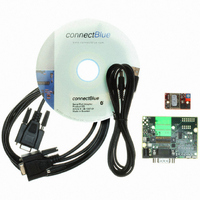CB-OWSPA311GI-01 ConnectBlue, CB-OWSPA311GI-01 Datasheet - Page 29

CB-OWSPA311GI-01
Manufacturer Part Number
CB-OWSPA311GI-01
Description
KIT START OEM WIRELESS LAN RS232
Manufacturer
ConnectBlue
Series
OEM Serial Port Adapter™r
Type
Bluetoothr
Datasheet
1.CB-OEMSPA311I-01.pdf
(60 pages)
Specifications of CB-OWSPA311GI-01
Frequency
2.4GHz
Lead Free Status / RoHS Status
Lead free / RoHS Compliant
Other names
809-1018
Example 8, Enable remote configuration
8.4 Use Cases
Use case 1, Sensor network, infrastructure, asynchronous
This example describes how to enable remote configuration, i.e. how to enter AT mode from a
remote peer. By default this functionality is disabled because it may pose a security risk. If re-
mote configuration is allowed, any remote peer may enter AT mode using the configured es-
cape sequence. From there, all configuration settings are exposed. With this in mind the follow-
ing steps are required to enable remote configuration.
1. Configure WLAN and IP settings.
2. Configure one or more remote TCP peers or enable the TCP listener (UDP peers don’t make
3. Enable remote configuration with the command AT*ACCB=1,1
The aim of these uses cases is to describe what to configure in different scenarios.
Problem description: An industry needs to monitor the air quality and humidity in a large as-
sembly hall. They have concluded that they need to place 20 sensors on different locations in
the assembly hall. They want the sensors to be battery powered and report the samplings wire-
lessly. The assembly hall already has an access point ready. The sensors report data every 10
seconds. The data packet sent is 1kb.
Security: WPA2 PSK.
Data delivery: All values are as important.
Solution:
Using an access point is preferable in this scenario since the devices will be battery powered. An
infrastructure network provides a lot better power saving properties than an ad-hoc network.
Using WPA2 PSK is no problem and we can follow Example 6, WLAN Connection with WPA2
Encryption to enter the correct parameters.
Since all values are important we choose a TCP connection for sending the data. This means
that somewhere on the network there has to be a computer with an open port accepting the
connections from the modules. We set up the connection parameters by following Example 2,
Enable DHCP and configure a Remote Peer.
The short interval of 10 seconds for every new packet means that we should not make the
module disconnect after a period of idle since booting up and scanning uses a lot of energy as
well as takes time.
4. Let the module associate with the network.
5. From any of the remote TCP peers send the escape sequence to enter AT mode (for more
6.
6. The module will now restart and associate with the access point and use the configured
sense because it is a one way communication channel).
information, see Chapter 2). Alternatively connect to the configured TCP listener and send
the escape sequence. The remote peer is now in AT mode and all AT commands are avail-
able. Several remote peers can be in AT mode at the same time without affecting the com-
munication with the other peers.
When configuration is finished, leave AT mode with the command AT*ADDM
static IP settings. When associated, it will try to connect to the remote peer
test.connectblue.se on TCP port 6666. The remote peer name will be resolved using the
configured DNS server.
Version 1.6.6 - 2009-11
29




















